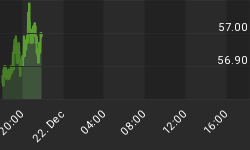The Federal Reserve, as was widely expected, announced nothing notable following its meeting today. I had thought there was a remote chance the Chairman would try to get one more dovish heave done before the new slate of Fed officials come in, but it was always a long shot. There is an old maxim that there is only one real vote on the FOMC, and that is the one that belongs to the Chairman. No Chairman has even been outvoted, or even vaguely challenged, in a recorded vote; this detail of Realpolitik means that whether Bernanke feels threatened by the onslaught of Ron Paul he is about to endure, he most likely feels no threat from the hawkish Fed Presidents that are about to acquire an official vote. At the end of the day, those votes are mostly pro forma.
The bond market really needed some kind of a dovish hint from the Fed, and perhaps for that reason it appears that some traders expected some indication of sympathy for the bondholders. Once the more-or-less unchanged statement was released, bonds took another hit on top of the shellacking they had already endured after Retail Sales this morning bested estimates comfortably (+1.2% on core retail sales, along with an upward revision to last month of +0.4%). The 10y note yield ended at 3.471% and the 10y TIPS yield all the way up to a plump 1.17% (well, compared to a month ago). The 30y TIPS got above 2% real yield for a little bit, down more than 2.5 points on the day.
I noted in the long-term chart I ran last week that the current bond market selloff was comparable in logarithmic magnitude to the one of 1987. That was 20bps ago. The current selloff is now the fourth-largest selloff of 90 calendar days or less since 1980. A mere 68 calendar days ago, on October 7th, 10y yields sat at 2.385%. They are now 45.5% higher at 3.471%. The table below (computed with Bloomberg 10-year yield closes) records the five largest routs in ratio terms of the last three decades (really, only four routs since the two separate legs of the 2009 selloff appear). Incredibly, Ben Bernanke has presided over three (two) of them, and those routs have occurred during the most aggressively easy monetary policy in history. Hint?

Red indicates a rout currently in progress.
Heck, this current rout even has another three weeks before it reaches the 90-day mark. Another 25bps and it will be the worst proportional selloff in history (over 90 days, anyway). By the way, if you need any reminder that we had a multi-decade bull market, notice that to get #5 on our list I had to go all the way back to Jimmy Carter near the blowoff conclusion of the 1970s bear market!
We will shortly find out how much of this is selling the rumor. Tomorrow's key economic release is CPI (Consensus: +0.2%/+0.1% ex-food-and-energy). The consensus forecast is actually for something a bit lower than 0.1%, since a print of exactly that number would raise the year/year core CPI to +0.7% on rounding but the consensus call is for 0.6% year/year. It would take an outright negative print on Core to induce a downtick to 0.5% year/year.
While I don't focus on forecasting month-to-month numbers, my model suggests we should have seen the low in core CPI. In other words, I think the bond market has the general idea right but has taken things too far. Remember, however, that in December the gamma-hedging effects will tend to make these trends persist longer than they would otherwise. To put it another way: I wouldn't fade the selloff, even though I think it's overdone. It is a flow-driven overreaction within the context of a market that is turning from secular bull to secular bear. That's not even worth a punt from the long side, especially given the fact that Empire Manufacturing (Consensus: +5.0 from -11.14) and Industrial Production/Capacity Utilization (Consensus: +0.3%/75.0%) among tomorrow's releases will both probably show some signs of firming. Empire was shockingly weak last month, but also an outlier, so improvement is probable (although a bounce all the way to +5 seems ambitious to me).
Neither the rise in rates nor the very modest signs of a halting recovery is likely to encourage the Fed to tighten or even to slow its easing campaign, unless it is accompanied by a meaningful rise in actual inflation out-turns. And I don't see that happening yet (it will be too late, once it does!). Employment is weak, and that's a political hot potato; moreover, there will be plenty of pressure from Congressman Paul's camp to stop the printing presses next year. The Fed is going to keep buying bonds for a while...but that doesn't mean we should.















